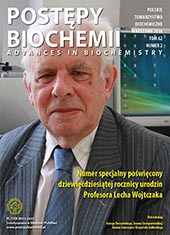Mechanisms of mitochondrial transport and distribution within the cell
Abstract
Mitochondria are multifunctional, dynamic organelles, which are continuously undergoing fusion and fission and are actively distributed within the cell. Mitochondria travel along microtubules together with a mitochondrial trafficking complex, formed by motor and adaptor proteins. Proper mitochondrial movements are crucial for neurons, in which mitochondria translocate in two directions. Anterograde transport is an outward movement of mitochondria from the cell body to the synapse, whereas retrograde is an inward movement away from the synapse or plasma membrane toward the cell body. This article presents a summary of current knowledge about the intracellular transport of mitochondria and its regulation in mammalian cells.
Downloads
Published
Issue
Section
License
All journal contents are distributed under the Creative Commons Attribution-ShareAlike 4.0 International (CC BY-SA 4.0) license. Everybody may use the content following terms: Attribution — You must give appropriate credit, provide a link to the license, and indicate if changes were made, ShareAlike — If you remix, transform, or build upon the material, you must distribute your contributions under the same license as the original. There are no additional restrictions — You may not apply legal terms or technological measures that legally restrict others from doing anything the license permits.
Copyright for all published papers © stays with the authors.
Copyright for the journal: © Polish Biochemical Society.




